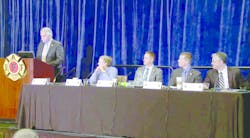A 20-year veteran firefighter at an urban fire department, John Smith had responded to every kind of imaginable—and unimaginable—emergency incident over the course of his career. Smith sees people on their worst days, and the incidents he responds to on a daily basis can be truly horrific. But it wasn’t until he saw a brother fall through the floor of a burning home to his death that the trauma stayed with him, and it seemed it would never get out of his mind. At the most unexpected times, he would relive the tragedy or hear his brother call for help. Every call—even the most routine of them—became a stressful experience.
Smith thought he just needed time to recover, but the anxiety only escalated. Even stepping foot in the firehouse or completing routine tasks became daunting. But he never told anyone about what he was experiencing.
One day, a crewmate took him aside and said, “I think I know what you’re going through, and I think I can help.”
Although this is a fictional account, it depicts an all-too-common behavioral health issue in the fire service.
About PTSD
Emergency responders are more susceptible to post-traumatic stress disorder (PTSD) because of the nature of the profession, coupled with the personal demands and challenges firefighters and paramedics face.
“IAFF members respond to any number of incredible events, many of them tragic,” says General President Harold Schaitberger. “PTSD is a terrible condition that affects firefighters and paramedics at double the rate of the general population, and we need a better way to deal with it.”
PTSD is among a long list of behavioral health issues facing first responders, and is an ever-growing problem in all ranks of the fire service. Yet all too often, programs for addressing behavioral health issues are not provided.
PTSD manifests following traumatic events. Symptoms include recurrent and persistent recollections or dreams about the event, intense distress when reminded of the trauma by another event and difficulty functioning and performing day-to-day tasks.
“Trauma is a daily occurrence in our lives,” says Dan DeGryse, a member of Chicago Local 2 who spent many years working with the fire department’s employee assistance program (EAP). He also helped develop behavioral health services, such as the department’s peer support network known as the Gatekeepers, and has completed a 20-year study on suicide in the fire service.
“All of this trauma has a cumulative effect, and it weighs heavily on us, just as it would on anyone,” he says.
Getting help
It is important to seek help when experiencing high levels of stress, especially post-traumatic stress. If left untreated, PTSD only worsens and can even lead to suicide or attempted suicide.
A number of states have introduced presumptive legislation that would add PTSD to the list occupational diseases in first responders for the purpose of workers’ compensation benefits. Presumptive PTSD laws would also help raise awareness about the disease.
Often, the stigma associated with needing help prevents many in the fire service from admitting something is wrong. In fact, in his study, DeGryse found that 28 percent of firefighters believe behavioral health issues might hurt their pride or reputation, worry that the information will not remain confidential or say they do not have or are not aware of services that address behavioral health issues.
“People with PTSD are six times more likely to attempt suicide compared to demographically matched controls,” says Dr. Suzy Gulliver, who has participated in a number of studies on PTSD, and currently is founding director and chief of the Warriors Research Institute (WRI), which engages in multidisciplinary studies on the traumatic stress experienced by both soldiers and first responders.
In just an 18-month period from 2008 to 09, Chicago Local 2 lost seven members to suicide. In 2010, four members of Phoenix Local 493 took their own lives.
Philadelphia, PA Local 22 has lost at least one member to suicide every year over the past five years. While each situation was different, Local 22 President Joe Schulle believes that work policies played a role.
“These policies are unnecessarily adding to our on-the-job stress,” he says. “We want to create the best possible environment, establish ways to identify any member who is having behavioral health issues and provide help before it gets worse.”
One workplace policy calls for Local 22 members to move to a new firehouse every year. “This is like taking our members out of their homes,” Schulle says. “A firehouse should be a comfort zone, not a place where you are constantly the new person getting used to a new environment.”
Another policy causing unnecessary stress affects Local 22 paramedics specifically. Medic units are required to go back into service within 20 minutes after each call. The tight turnaround makes it difficult for paramedics to get paperwork done and the medic unit cleaned up, let alone decompress from a difficult call.
“In Philadelphia, New York, Toronto and all across the IAFF, we are losing too many of our own,” Schaitberger says.
Available programs
Frank Leto, a member of the Uniformed Fire Officers Association (UFOA) of New York Local 854 who has spent many years managing the FDNY Counseling Service Unit identifies awareness as a key to reducing the stigma. “It is important to make sure the behavioral health services are there and are kept confidential,” he says.
But only a few departments provide these programs.
The FDNY Counseling Service Unit offers peer counseling and treatment services for substance abuse and related problems. “We start in recruit school, making sure our rank-and-file know about the services available,” Leto says. “Not only does this help reduce the stigma, the constant reminder that services are there increases the likelihood that our members will reach out and accept help when they need it.”
In Chicago, one of the most effective aspects of the department’s EAP is the Gatekeepers Peer Support Network.
“Our peer counselors understand the importance of confidentiality,” DeGryse says. “In addition, peer counselors wear a special patch to make themselves very identifiable and accessible.”
After losing four Phoenix Local 493 members to suicide in 2010, the local formed a task force to address behavioral health. What emerged is the Firestrong (firestrong.org) wellness program.
“The online resource provides information about PTSD and related behavioral health concerns, but it also tells our members where to find support and other help in and outside the department,” says Local 493 president Stephen Beuerlein.
In Washington State, Safe Call Now offers first responders a confidential 24-hour hotline. State Senate Bill 5131, passed in 2009, ensures that records from crisis intervention referral services like Safe Call Now cannot be subpoenaed.
In addition to being confidential under state law, Safe Call Now has established a national network of dual-diagnosis providers who are knowledgeable about insurance options to minimize the financial impact.
“Our members worry that a call to a behavioral health services hotline may later be used against them,” says Seattle Local 27 President Kenny Stuart. Local 27 has long been a great supporter of Safe Call Now. “Callers feel safe. That’s important,” he says.
Call-takers are also firefighters and police officers, many of who have experienced behavioral health issues of their own.
A similar program, the Firefighter Crisis Support and Suicide Awareness Support Line, established two years ago by the Professional Firefighters of Utah (PFFU), “is saving lives,” says PFFU President Jack Tidrow.
Unfortunately, in many departments, even if the stigma is reduced, there are no programs in place for addressing behavioral health issues. Others may offer employee assistance programs (EAPs) but these are simply a referral line to community services.
“We need to do a better job of recognizing the signs and symptoms and providing the tools to help address it,” Schaitberger says. “Behavioral health services need to be embedded in all fire departments.”
PAT MORRISON is the Assistant General President for Health, Safety and Medicine of the International Association of Firefighters.
SIDEBAR 1
Behavioral Health Resources for IAFF Members
To address the growing concern over PTSD, suicide and other behavioral health issues, the IAFF is developing new resources and tools designed to help affiliates and members recognize the signs and symptoms and provide best practices for addressing these issues.
The IAFF developed a workshop on PTSD for its 2015 Affiliate Leadership Training Summit in Anaheim, CA. The video is available to all members on IAFF-TV (www.youtube.com/iafftv).
Further, the IAFF recently unveiled a new peer training and certification program designed to help affiliates establish behavioral health services for their members. In addition, the IAFF is revising the behavioral health chapter of the Wellness-Fitness Initiative (WFI) guidebook.
Working with researchers at Texas A&M College of Medicine and Baylor Scott & White Healthcare, the IAFF also offers new resources for IAFF members dealing with the tragic loss of a fellow brother or sister to suicide.
Funded by a FEMA Fire Prevention and Safety grant, researchers from Texas A&M and Baylor Scott & White Healthcare developed a standard operating procedures (SOP) for fire departments to use in the wake of a member suicide, as well as an educational and awareness brochure. The SOP was designed to be used by a variety of departments and can be edited to fit different departmental policies and structures.
For additional information, visit the Health and Safety page on the IAFF website or contact the Health and Safety Division at (202) 824-1571.

Pat Morrison
Pat Morrison is the Assistant General President for Health, Safety and Medicine of the International Association of Fire Fighters.






